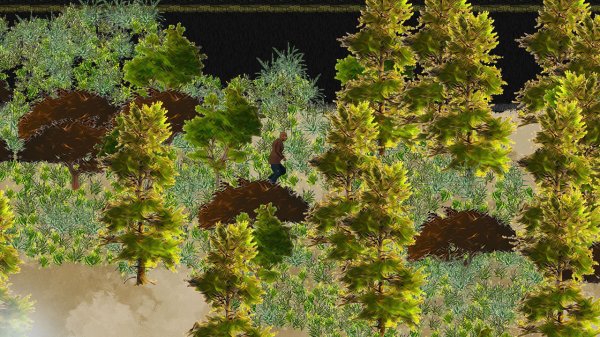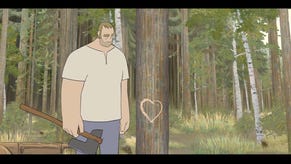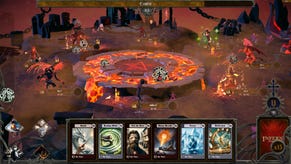Arcen Talk A Valley Without Wind, Part 1
Arcen Games, famed for AI War, financial troubles, and causing a shortage of iron, have announced their new game: A Valley Without Wind. It's quite the concept: survival in a procedurally generated world, exploration, magic, and... perma-death? Interesting. Read on to find out more. (So much more, that there's another instalment tomorrow.)
RPS: Can you start by explaining who Arcen Games is, and the basic premise of A Valley Without Wind?
Park: Arcen Games is a small indie development studio that I founded in 2009, and our first title was AI War: Fleet Command. That grew to be something of a cult classic in the hardcore strategy niche, and so now we've just released our third expansion for AI War, as well as bringing it up to version 5.0. In 2010 we worked on our second full game, a block-based puzzler called Tidalis -- knowing that we didn't want to get stuck in any one genre permanently. A Valley Without Wind (or AVWW for short) is thus our third full game, and our third genre to work in, as well.
AVWW is an adventure game with a focus on exploration and discovery in huge, procedural 2D worlds. There are a few JRPG inspirations here and there, such as having concepts like stats and levels, but in gameplay it's all action-adventure. There's a fair emphasis on traps and magic and monster avoidance, though -- it's not a hack and slash, and while combat is quite important it's definitely secondary to exploration.

RPS: What's the premise for AVWW? What're the threats, how does the magic work?
Park: Your first character, who is selected from a small stable of randomly-generated characters when you start a new world, is just one of many low-level survivors in the world. The character is alone, surrounded by monsters like everyone else, and just kind of scraping by. This has been just the way of life for most characters in the world for as long as they can remember, for generations.
You the player are put in charge of this character's well being. What will you do? You can certainly just continue scavenging, and hanging around the starting area. But as you explore around you'll build some basic traps and weapons, and you'll find a few caches of small odds and ends. Before too long, you'll inevitably meet another NPC of some sort, and can start talking to them to make use of their crafting abilities.
Eventually as you continue to explore new places and meet new people, larger conflicts become apparent. Various Bad Things are going on in the immediate area, and you can choose to do something about it... or not. As you're doing all of this, of course, your character is gaining in levels, gaining new equipment, and picking up all sorts of odds and ends for crafting. At some point you'll find a good location for your first settlement, and you can start inviting NPCs there. At some point you'll likely have your first character die, and you'll choose a replacement to control from among the NPCs you've met.
The threats are a variety of monsters and mutated animals and plants, as well as occasionally other humans. There isn't a broad way to classify this, as it isn't a "zombie game" or anything like that. Depending on the region, the types of monsters are different. Above-ground, it's heavier on the mutated animals, and occasionally undead type things. Underground, it trends more to the fantastical with a lot of evil stuff lurking there. Basically anything from fantasy, sci-fi, or any mix is something we consider fair game. There will be a few high-technology futuristic encampments, and not all of them are benevolent.
This mix of magic and technology is something I've really loved ever since encountering it in the classic NES game Crystalis. Certainly it's been explored in many games since then, but there's a specific feel to those 80s Japanese games and movies that really feels different to me. I'm hoping to recapture at least some of that feel with AVWW.
Magic power is granted by special gems that can be found underground. Each gem enables the wielder to use a specific spell, although the gem has to be prepared first by an Enchanter (one of the five classes of crafter in the game) before it can be used. The raw gems actually can be prepared in one of several ways, granting one of several spells, and so during the crafting process you choose which one you want to make the permanent end result of the raw gem.
In terms of using spells, some the low-level those will be simply recharge-based, so that you can use them repeatedly, but just not too close behind one another. We might use a similar system for the higher-level spells, or we might use a mana/magic points system. That part honestly hasn't been fully figured out yet, because we really need to have some internal playtesting before we figure out what feels like the most fun. We know we want to have some unlimited-use low level spells so that you're never completely out of "ammo" on your long treks. But at the same time you're never meant to feel like a godlike powerhouse just roaming everywhere and blasting everything at will. So the final spellcasting design will probably evolve some, but that's the end effect we're aiming at.

RPS: Originally, AVWW was announced as a tower defense game, with Alden Ridge being announced along side it. What happened?
Park: Alden Ridge was the project I was working on by myself back in 2008, before ever founding Arcen or having any kind of team. I spent a solid 8 months on it and then got stuck with one aspect of the design that wasn't working out like I hoped, and so started occupying myself with the "side project" of AI War. Then of course AI War became this all-consuming thing and I haven't had a chance to return to Alden Ridge in the intervening years.
AVWW-the-tower-defense-game was something we talked about in late 2009 and all through 2010, and it was something that we'd planned to be our next full project after Tidalis. Problem was, when we hit that point of actually starting on the tower defense game, we were less enthused about it. There are just so many tower defense games these days, and meanwhile a lot of other design ideas had been coalescing in my mind and with the team. We're always just full of ideas, and so when a year passes between the concept of a game and actually getting to implement it, the implementation tends to be radically different!
RPS: Is Alden Ridge gone?
Alden Ridge isn't completely gone, but that's not the game we're making at the moment. About 80ish levels for Alden Ridge are actually complete, so it would be a shame to throw those away, but I still don't yet have the solution for the design issue that's been stymieing me on that project. So for now it's shelved, and AVWW has changed so much that it bears almost no resemblance to what we announced in late 2009. The general post-ice-age setting is the same, and... I think that's it? The new concept for AVWW ties together our favorite ideas from Alden Ridge, the setting from the original AVWW concept, and adds in a whole lot of new ideas we've had in the meantime.

RPS: With games set in a post apocalyptic environment, there's always a heavy sense of survival and survivors in the world, even if the games themselves don't always play towards that. How have you made the setting affect the game?
Park: Actually, it's pretty central to the gameplay, underpinning pretty much every aspect of it. There's no economy in a post-apocalyptic setting like this, so it's all a matter of making what you need. To that end, when you're out exploring on your own, you'll be picking up materials from caves, old office buildings, factories, and so on. Then you can do some crafting yourself to make weapons, armor, consumables, traps, and magic items. But for a lot of that crafting, you have to seek out other survivors (NPCs) and have them do the crafting for you.
One of the big themes of this game is going to be making the world a less depressing place for the characters to inhabit. Everyone is alone or in really tiny bands, and in constant danger. As you explore around, you can find settlement locations and encourage the characters you meet to go and live there in larger groups. This is useful in terms of having all your allies and crafters in a centralized location, but it also changes the landscape of the world in other ways. A lot of these settlement-related mechanics are something that will be built in after we hit the point of public alpha with the game, but we've been undergoing intensive design on these aspects and are really excited about them.
RPS: There's a very nature-heavy focus from what I've read about AVWW, not least because it's the sort of world reclaiming type of post apocalypse, where the traces of man are getting wiped out by biology.
Park: There's really a mix of nature and technology here, that's very true. In most places, the technology is old and outdated (and most importantly, broken). For the most part, you won't be driving around in cars, though you will see them stranded on old highways, in suburban driveways, etc. And the plants and grass are all unruly, growing up everywhere, crossing the boundaries of roads and things and basically making a mess of the whole terrain. Going along with that, chasms are a big thing, and having these huge holes and cliffs in disconcerting places is definitely a theme. Often there are strange plants or even monsters crawling out of these.
RPS: Is this having mechanical effects on how the game plays as well?
Park: Mechanically, this whole state of ruin has a lot of effects. When you are dealing with enemies, if you are outside, often they will be somewhat camouflaged by all the plant life. That's not something you see in a lot of 2D games, but it's a staple of a number of first person shooters I've enjoyed. I thought that would be really interesting to see here. Plus, all the plant life is constantly moving slightly, blowing in the breeze, so that even masks the movement of enemies to a small degree, creating a greater sense of unease and exposure when being out in the wild.
By contrast, this lets the indoor areas, which will be largely dark and filled with trash, feel even more sterile. You go from this really lush, constantly moving outdoor area to this dark, dingy, very still internal area with different moods of music. A little movement in the corner might just be some small harmless animal, or it might be something much worse.
RPS: Does that mean you’re creating a deliberately hostile environment and putting the player on edge?
Park: Fear isn't something we're intentionally cultivating in the sense of a horror game -- there's no blood or gore or anything -- but I think that to really feel like you're a brave adventurer out in the wilds, there has to be a certain gravitas, a certain the-world-is-larger-than-me feeling to the surroundings. The combat mechanics also emphasize this, as your prowess in hand-to-hand combat is somewhat questionable, and you're better off using ranged attacks or traps to deal with enemies -- or to avoid them entirely when possible on long treks. You're not just Hero Dude out there slaughtering everything that moves, you're actually in very real danger the entire time, and have to make your way through each area accordingly.

RPS: Is this tying into the use of permanent character death? Creating a consequence for failure beyond merely being set back five minutes?
Park: The tendency when one hears "perma-death" is to think of the uber-hardcore -- but that isn't where we're trying to go at all. In a lot of respects our system is more forgiving, because it is literally impossible to lose at this game. You will die, and you will have massive tragic graveyards of fallen characters you liked, and you can have the game be quite a difficult beast if you want to push to the limits of where your levels and equipment will let you travel.
On the flip side, you can stay closer to home and play the game more casually, with vastly lower difficulty. Sure, the game gives out less rewards in that fashion -- fortune does favor the bold -- but there's a very natural difficulty curve in there. The perma-death aspects are something that I've personally been really worried that players will misunderstand as a sign of "this game is ultra hardcore and not forgiving." I explained it to my wife, expecting a negative reaction, but was really surprised that she took to it immediately, in the context of the larger mechanics of this specific game.
It boils down to why we have perma-death: it's about grounding the characters in the world, and creating a real sense of consequences. We aren't out to punish the player -- there's no purpose or fun in that. But one of the big problems with some games is that there is just no sense of reality, or of danger. I really admired Demon's Souls for how it created fear in the player via its death mechanic. Granted, that was an uber-hardcore game, and I eventually gave up on it after a few areas. I still thought it was worth the money for the lessons it taught me, though.
In the case of AVWW, we wanted a really forgiving system where you never have "wasted time" by being out and adventuring. If you go out on a long haul and gain a bunch of experience and levels, then by god you get to keep those no matter what happened. That said, if there are no consequences to death, then it winds up feeling way too tame and uninteresting no matter how far you travel. I absolutely adore Zelda games, but it's definitely a lighthearted series where no matter where you go exploring, you don't ever feel in mortal danger if you're pretty good at the game. You can always run away or otherwise escape. That's not at all the tone I wanted for AVWW.
Therefore, when you die your character is gone permanently, but they also leave a lasting mark on the world and are remembered. Isn't it annoying when games act like past events never happened? Whatever inventory and equipment the character was carrying is not lost, but is dropped in a "magic bag" or similar where the character fell. So if you had a Legendary Sword of Awesomeness, and your character dies, that sword isn't lost -- it just might be inaccessible for a while. Or you can make a run into the dangerous area with your new character and an inferior weapon, grab your old character's stuff and hightail it out of there. Another example of not needing to fight every monster you run across, that would be a specific example of when avoidance might be best.
The character-death aspect is something we're trying to push in a new direction, where it creates the appropriate mood and atmosphere to the game without leading to a sense of player punishment and frustration. That's tricky to convey when using off-hand phrases like "perma-death," which have entirely the wrong connotations, so I'm really glad you asked me about that.

RPS: Can you explain about how the difficulty is tied to the terrain and direction?
Park: AVWW will have an overworld system, where there are specific "region tiles" that you can venture into and explore. Each one of those regions is potentially enormous, and the type of tile on the overworld speaks to the type of region it will be. So, it might be snowy woods, or a desert, or an old city, or an office park, suburbs, volcano, mountain, beach, whatever. You see these things on the overworld, and you can go into anything you can see.
The world map itself expands infinitely in all directions, so you'll wind up skipping most regions on the map and just going to the ones that interest you at the time. One key component of each region tile, aside from just what type of region it is, is what Difficulty Level it is. You as a player have a level in a JRPG sort of sense, and whatever character you are controlling at the time takes on that level (individual characters are permanently gone when they die, so this player-persistence-of-stats is really important).
The world map is arranged such that you can get the difficulty level you want to play at at any given time. If you travel east from your starting location, the difficulty levels go up linearly. Travel west from your starting location, and it's a rather mottled affair: it's mostly a lower difficulty, but with pockets of very high difficulty. Travel north or south, and the difficulty level stays generally constant with whatever your x coordinate is.
RPS: Overworld Travel?
Park: Overworld travel itself is dangerous, I should add, so you can't just go infinitely in any direction with ease. Every few tiles on the overworld, you wind up "getting lost in a windstorm," which is part of the theme talked about in the title of the game. When you get lost in a windstorm, you're sucked into that region at some random location far in, with atypically harsh weather (rain, snow, sandstorm, whatever), and atypically difficult monsters roaming about in larger numbers. In some cases, it may also be night, or other similar effects. Once you escape the region, you can continue traveling on the overworld as normal.
Of course, there needs to be a way to fast-travel once you've explored a bit, so one key mechanic is building "wind shelters" on individual region tiles. These shelters get built when you accomplish special objectives in the region in question (the objectives varies from region to region). Over time, you can therefore have these networks of wind shelters on the overworld map, which let you avoid getting lost when the windstorms come up. It makes travel in known areas quite safe and fast, but travel in the more uncharted regions quite a bit more dangerous. There's a lot of room for some strategy on how to set up wind shelter networks for the players to figure out, too. Lots of room for player choice and individualized playstyles.
Tune in for part two of this discussion tomorrow!
Trees!









